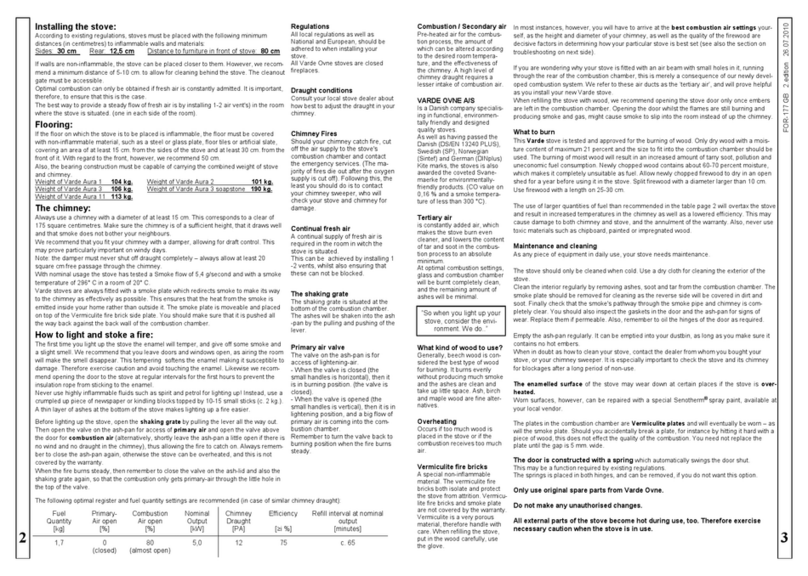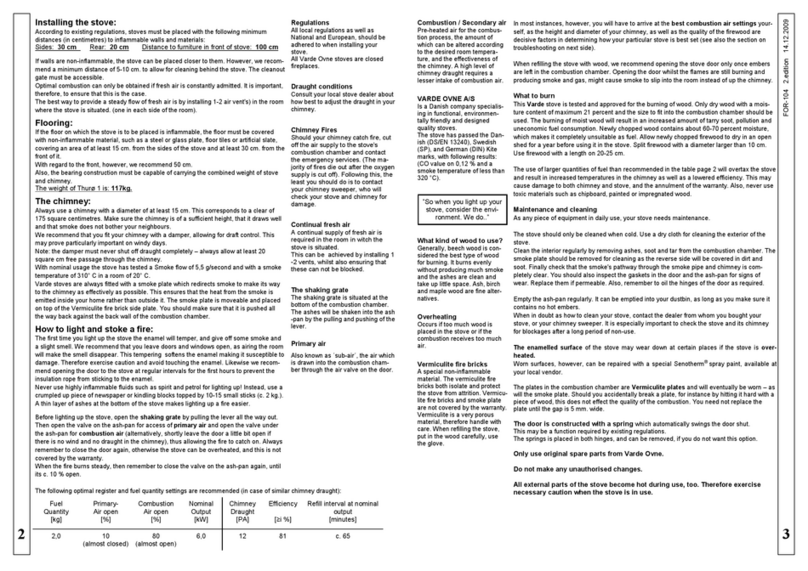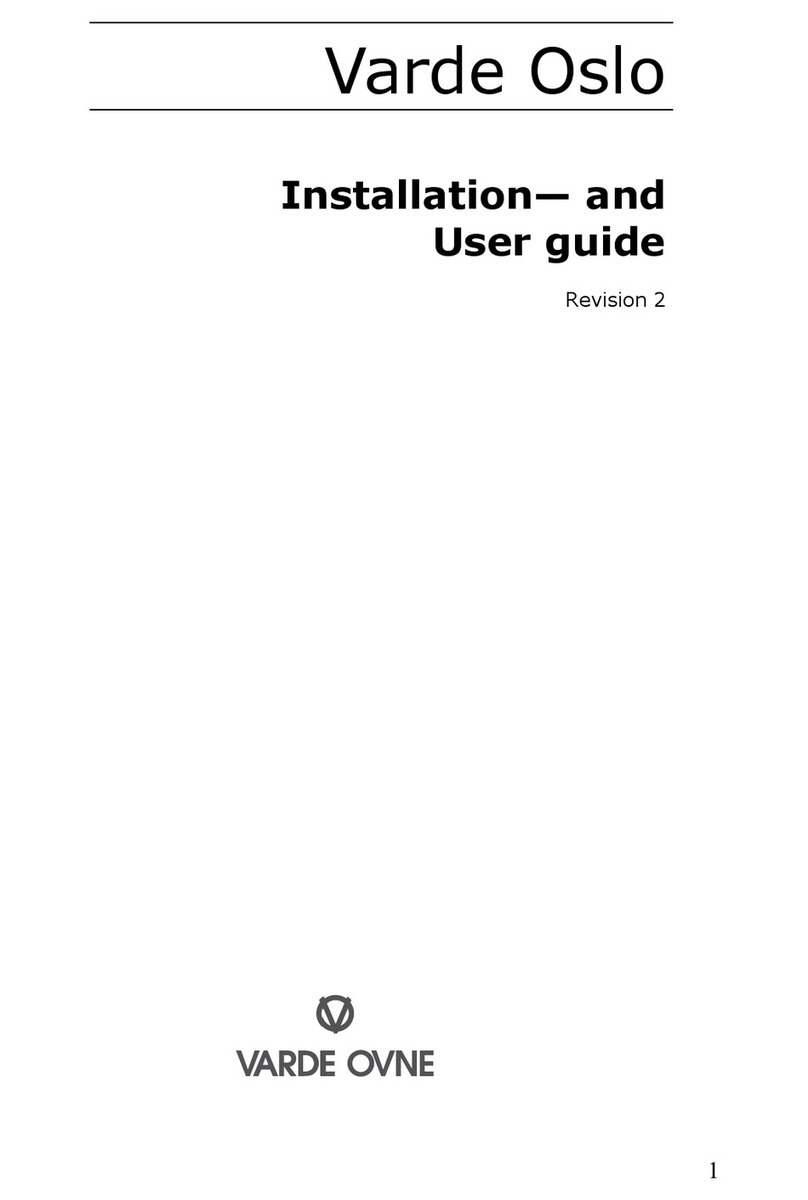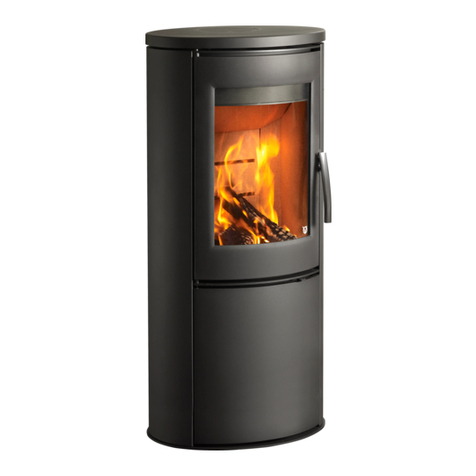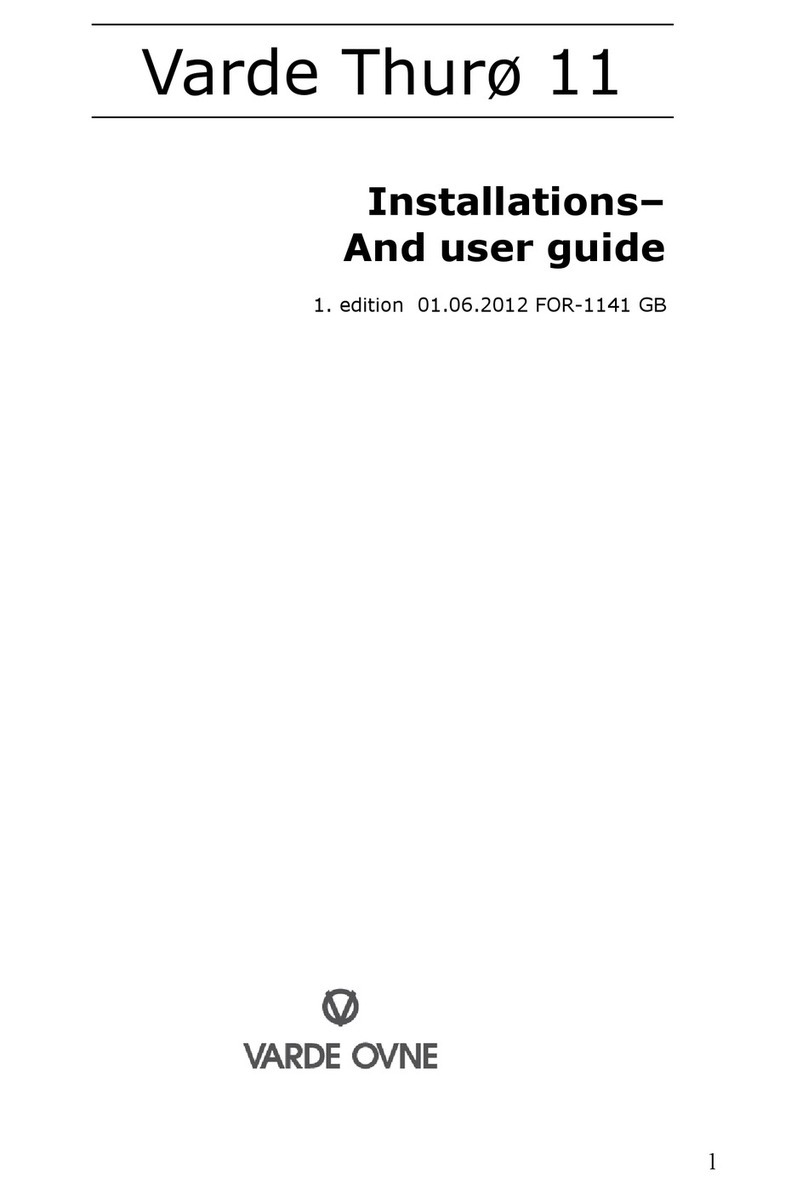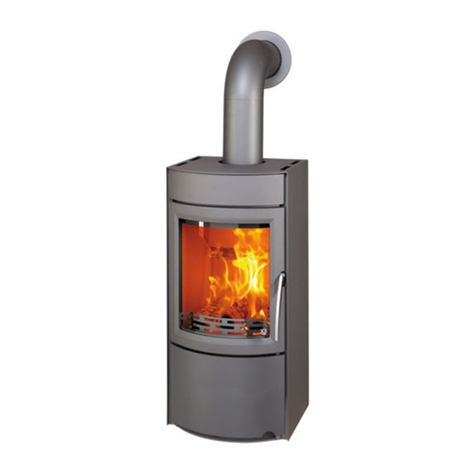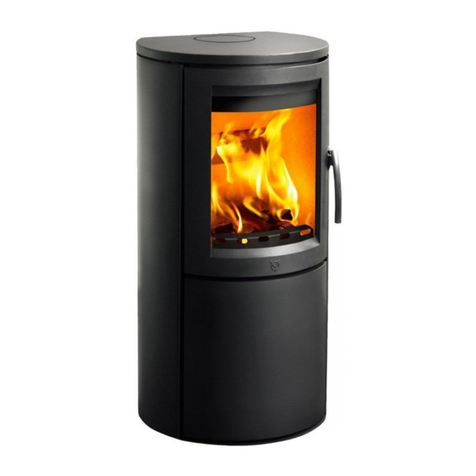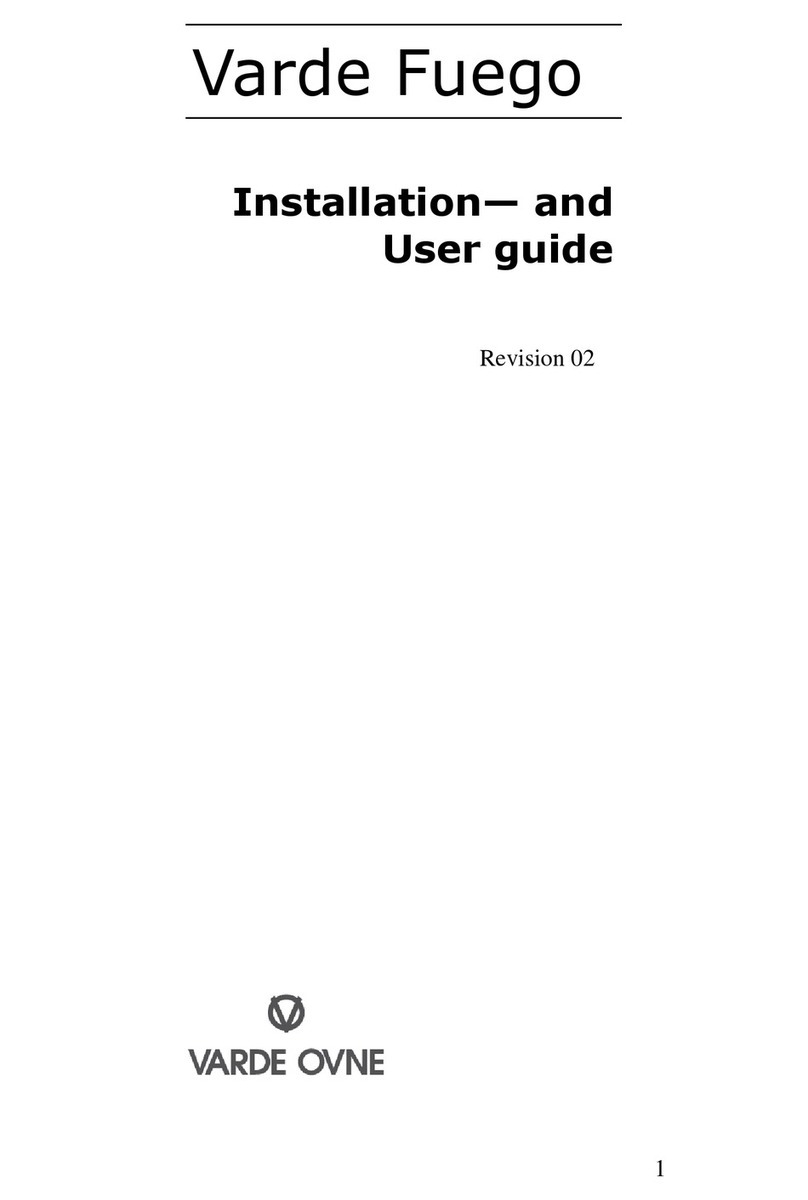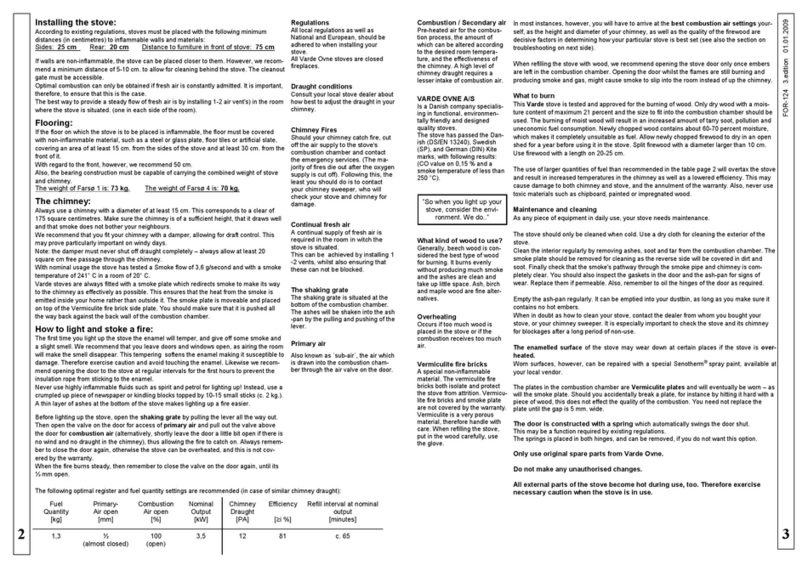
Installing the stove:
According to existing regulations, the stoves must be placed with the following minimum
distances (in centimetres) to inflammable walls and materials:
Varde Front-Line 55: Sides: 35 cm Rear: 35 cm
Distance to furniture in front of stove: 110 cm
The stove must be placed with this minimum distance to the floor: 30 cm
If walls are non-inflammable, the stove can be placed closer to them. However, we recom-
mend a minimum distance of 2-10 cm.
The cleanout gate must be accessible.
Optimal combustion can only be obtained if fresh air is constantly admitted. It is important,
therefore, to ensure that this is the case.
The best way to provide a steady flow of fresh air is by installing 1-2 air vent's in the room
where the stove is situated. (one in each side of the room).
Flooring:
If the floor where the stove is to be placed is inflammable, the floor must be covered with
non-inflammable material, such as a steel or glass plate, floor tiles or artificial slate, cover-
ing an area of at least 15 cm. from the sides of the stove and at least 30 cm. from the front
of it. With regard to the front, however, we recommend 50 cm.
Also, the bearing construction must be capable of carrying the combined weight of stove
and chimney. Read the table on page 4, to find out how much your stove weights.
The chimney:
Always use a chimney with a diameter of at least 15 cm. This corresponds to a clear of
175 square centimetres. Make sure the chimney is of a sufficient height, that it draws well
and that smoke does not bother your neighbours.
We recommend that you fit your chimney with a damper, allowing for draft control. This
may prove particularly important on windy days.
Note: the damper must never shut off draught completely –always allow at least 20
square cm free passage through the chimney.
Varde stoves are always fitted with a smoke plate which redirects smoke to make its way
to the chimney as effectively as possible. This ensures that the heat from the smoke is
emitted inside your home rather than outside it. The smoke plate is moveable and placed
on top of the Vermiculite fire brick side plate. You should make sure that it is pushed all
the way back against the back wall of the combustion chamber.
How to light and stoke a fire:
The first time you light up the stove the enamel will temper, and give off some smoke and
a slight smell. We recommend that you leave doors and windows open, as airing the room
will make the smell disappear. This tempering softens the enamel making it susceptible
to damage. Therefore exercise caution and avoid touching the enamel. Likewise we
recommend opening the door to the stove at regular intervals for the first hours to prevent
the insulation rope from sticking to the enamel.
Never use highly inflammable fluids such as spirit and petrol for lighting up! Instead, use a
crumpled up piece of newspaper or kindling blocks topped by 10-15 small sticks (c. 2 kg.).
A thin layer of ashes at the bottom of the stove makes lighting up a fire easier.
Before lighting up the stove, open the valve under the door for combustion air.
After lightening the fire, you can ad extra oxygen by opening the door a little bit, (the door
handle has 2 steps: In step 1 the door is closed and in burning positing. In step 2 the door
is a little bit opened and in lighting position).
When the fire burns steady, then always remember to close the door again, otherwise the
stove can be overheated, and this is not covered by the warranty.
Regulations
All local regulations as well as
National and European, should be
adhered to when installing your
stove.
All Varde Ovne stoves are closed
fireplaces.
Draught conditions
Consult your local stove dealer about
how best to adjust the draught in your
chimney.
Chimney Fires
Should your chimney catch fire, cut
off the air supply to the stove's
combustion chamber and contact
the emergency services. (The ma-
jority of fires die out after the oxygen
supply is cut off). Following this, the
least you should do is to contact
your chimney sweeper, who will
check your stove and chimney for
damage.
Continual fresh air
A continual supply of fresh air is
required in the room in witch the
stove is situated.
This can be achieved by installing
1-2 vents, whilst also ensuring that
these can not be blocked.
Combustion / Secondary air
Pre-heated air for the combustion
process, the amount of which can be
altered according to the desired room
temperature, and the effectiveness of
the chimney. A high level of chimney
draught requires a lesser intake of
combustion air.
VARDE OVNE A/S
Is a Danish company specialis-
ing in functional, environmen-
tally friendly and designed
quality stoves.
As well as having passed the
Danish (DS/EN 13240 PLUS),
Swedish (SP) and Norwegian
(Sintef) Kite marks, the stoves is
also awarded the coveted
Svanemaerke for environmen-
tally-friendly products. (CO value
on less than 0,20 % and a
smoke temperature of less than
275 °C).
Tertiary air
is constantly added air, which
makes the stove burn even
cleaner, and lowers the content
of tar and soot in the combus-
tion process to an absolute
minimum.
At optimal combustion settings,
glass and combustion chamber
will be burnt completely clean,
and the remaining amount of
ashes will be minimal.
What kind of wood to use?
Generally, beech wood is con-
sidered the best type of wood
for burning. It burns evenly
without producing much smoke
and the ashes are clean and
take up little space. Ash, birch
and maple wood are fine alter-
natives.
Overheating
Occurs if too much wood is
placed in the stove or if the
combustion receives too much
air.
Vermiculite fire bricks
A special non-inflammable
material. The vermiculite fire
bricks both isolate and protect
the stove from attrition.
Vermiculite fire bricks and
smoke plate are not covered by
the warranty. Vermiculite is a
very porous material, therefore
handle with care.
When refilling the stove, put in
the wood carefully, use the
glove.
In most instances, however, you will have to arrive at the best combustion air settings your-
self, as the height and diameter of your chimney, as well as the quality of the firewood are
decisive factors in determining how your particular stove is best set (see also the section on
troubleshooting on next side).
If you are wondering why your stove is fitted with an air beam with small holes in it, running
through the rear of the combustion chamber, this is merely a consequence of our newly devel-
oped combustion system. We refer to these air ducts as the ‘tertiary air’, and will prove helpful
as you install your new Varde stove.
When refilling the stove with wood, we recommend opening the stove door only once embers
are left in the combustion chamber. Opening the door whilst the flames are still burning and
producing smoke and gas, might cause smoke to slip into the room instead of up the chimney.
What to burn
This Varde stove is tested and approved for the burning of wood. Only dry wood with a mois-
ture content of maximum 21 percent and the size to fit into the combustion chamber should be
used. The burning of moist wood will result in an increased amount of tarry soot, pollution and
uneconomic fuel consumption. Newly chopped wood contains about 60-70 percent moisture,
which makes it completely unsuitable as fuel. Allow newly chopped firewood to dry in an open
shed for a year before using it in the stove. Split firewood with a diameter larger than 10 cm.
Use firewood with a length on 20-25 cm.
The use of larger quantities of fuel than recommended in the table page 2 will overtax the stove
and result in increased temperatures in the chimney as well as a lowered efficiency. This may
cause damage to both chimney and stove, and the annulment of the warranty. Also, never use
toxic materials such as chipboard, painted or impregnated wood.
Maintenance and cleaning
As any piece of equipment in daily use, your stove needs maintenance.
The stove should only be cleaned when cold. Use a dry cloth for cleaning the exterior of the
stove.
Clean the interior regularly by removing ashes, soot and tar from the combustion chamber.
The smoke plate should be removed for cleaning as the reverse side will be covered in dirt
and soot. Finally check that the smoke's pathway through the smoke pipe and chimney is
completely clear. You should also inspect the gaskets in the door and the ash-pan for signs of
wear. Replace them if permeable. Also, remember to oil the hinges of the door as required.
Empty the ash-pan regularly. It can be emptied into your dustbin, as long as you make sure it
contains no hot embers.
When in doubt as how to clean your stove, contact the dealer from whom you bought your
stove, or your chimney sweeper. It is especially important to check the stove and its chimney
for blockages after a long period of non-use.
The enamelled surface of the stove may wear down at certain places if the stove is
overheated.
Worn surfaces, however, can be repaired with a special Senotherm® spray paint, available
at your local vendor.
The plates in the combustion chamber are Vermiculite plates and will eventually be worn,
–as will the smoke plate.
Should you accidentally break a plate, for instance by hitting it hard with a piece of wood, this
does not effect the quality of the combustion. You need not replace the plate until the gap is 5
mm. wide.
Only use original spare parts from Varde Ovne.
Do not make any unauthorised changes.
All external parts of the stove become hot during use, too.
Therefore exercise necessary caution when the stove is in use.
Test results:
With nominal usage in a roomtem-
perature on 20° C, the stove has
following test results:
Front-Line 55:
- Smoke flow of 6,8 g/second
- Smoke temperature of 274° C
The following optimal register and fuel quantity settings are recommended (in case of similar chimney draught):
Fuel
Quantity
[kg]
Combustion
Air open
[%]
Nominal
Output
[kW]
Chimney
Draught
[PA]
Efficiency
[≥i %]
Refill interval at nominal
output
[minutes]
2,4 75 7,0 12 77 c. 60
Front-Line 55:
2
3
FOR-166 GB 1.edition 06.10.2008
”So when you light up your
stove, consider the envi-
ronment. We do..”
